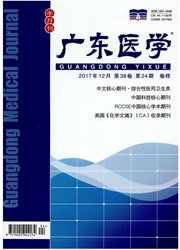

 中文摘要:
中文摘要:
目的:探讨1-磷酸鞘氨醇(S1P)在高糖诱导血管内皮细胞功能损伤中的作用及其机制。方法:在高糖培养的人主动脉内皮细胞模型中,分别或同时给予S1P、鞘氨醇激酶1抑制剂和Akt抑制剂处理后,观察一氧化氮(NO)、粒细胞-内皮细胞黏附率、细胞间黏附分子1(ICAM-1)蛋白表达、内皮细胞迁移以及Akt/内皮型一氧化氮合酶(e NOS)信号途径的改变。结果:S1P明显降低高糖诱导的内皮细胞培养上清液中NO含量,促进粒细胞与内皮细胞黏附,显著增加内皮细胞ICAM-1蛋白表达,抑制内皮细胞迁移和Akt/eNOS信号通路激活。鞘氨醇激酶1抑制剂减少S1P生成后上述内皮细胞功能指标得以明显改善,Akt/e NOS信号通路恢复激活。结论:S1P促进高糖培养的内皮细胞功能障碍的形成,可能与其抑制Akt/e NOS信号通路激活有关。抑制S1P生成有望成为减轻内皮细胞功能损伤的治疗策略之一。
 英文摘要:
英文摘要:
AIM: To explore the role of sphingosine 1-phosphate (SIP) in the dysfunction of vascular endo- thelial ceils exposed to high glucose. METHODS: In human aortic endothelial cells cultured under high-glucose (22 mmol/L glucose) medium, nitric oxide (NO) level, polymorphonuclear neutrophil-endothelial cell adhesion rate, protein level of intercellular adhesion molecule-1 ( ICAM-1 ), migration of endothelial ceils and Akt/endothelial nitric oxide syn- thase (eNOS) pathway activation were observed after SIP, sphingosine kinase-1 inhibitor and/or Akt inhibitor treatments. RESULTS: S1P decreased NO level, increased polymorphonuclear neutrophil adhesive rate, enhanced ICAM-1 protein level, and inhibited migration of endothelial cells and activation of Ak/eNOS pathway in endothelial ceils cultured under high-glucose condition. Sphingosine kinase-I inhibitor , which reduced S1P content, significantly improved the above endo- thelial ceil function indexes and restored the activation of Akt/eNOS pathway. CONCLUSION: S1P promoted high glu- cose-induced dysfunction of endothelial cells probably by inhibiting the activation of Akt/eNOS signal pathway. Targeting SIP is expected to become one of potential treatment strategies to reduce endothelial ceil dysfunction.
 同期刊论文项目
同期刊论文项目
 同项目期刊论文
同项目期刊论文
 期刊信息
期刊信息
